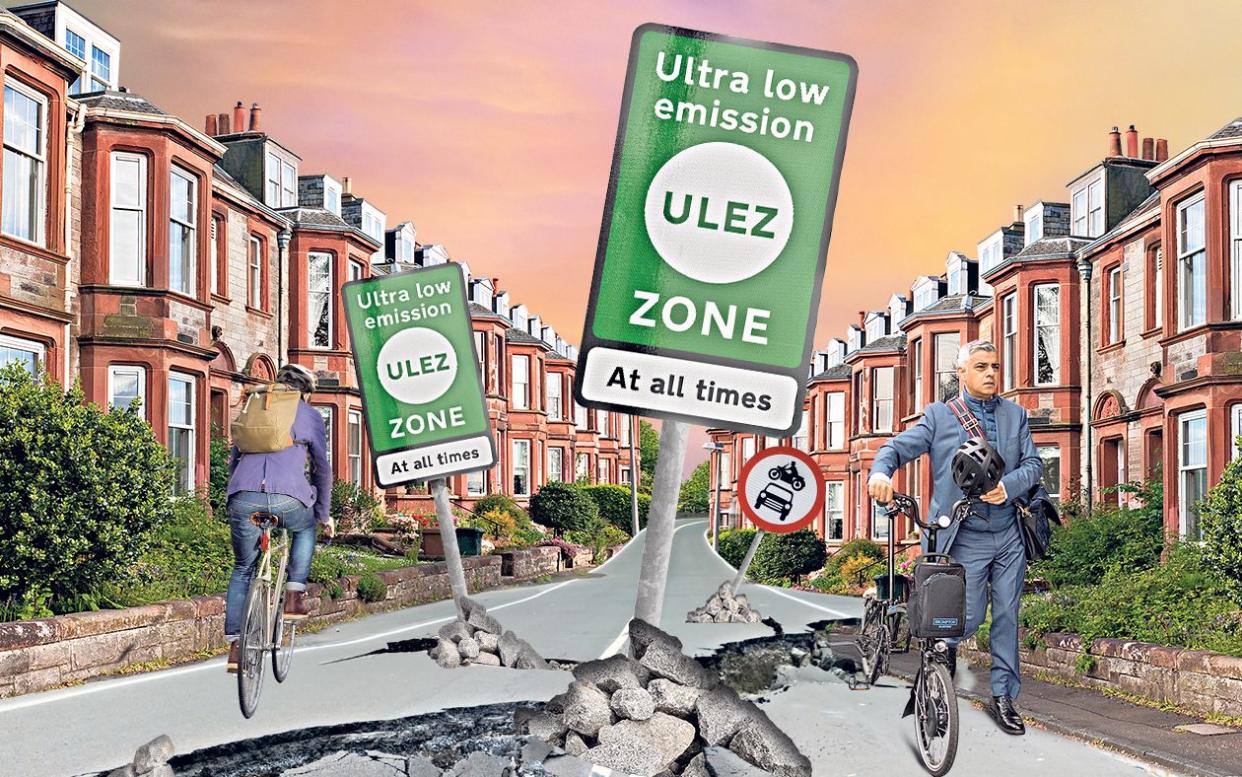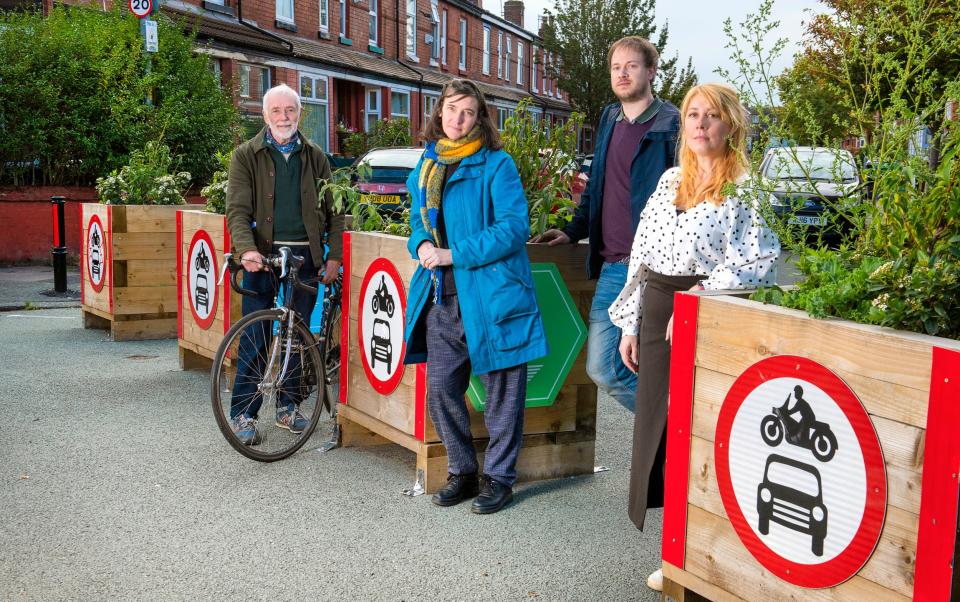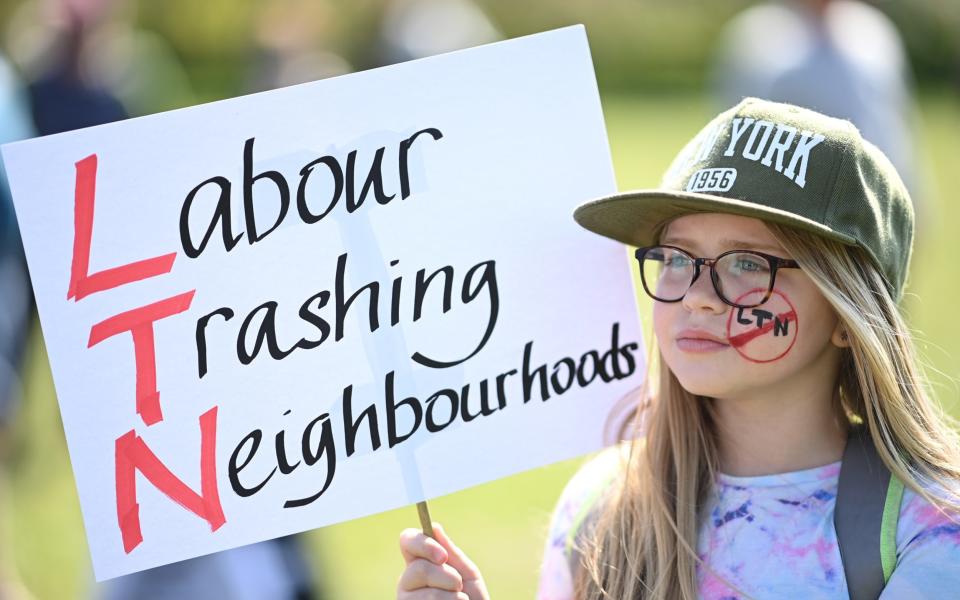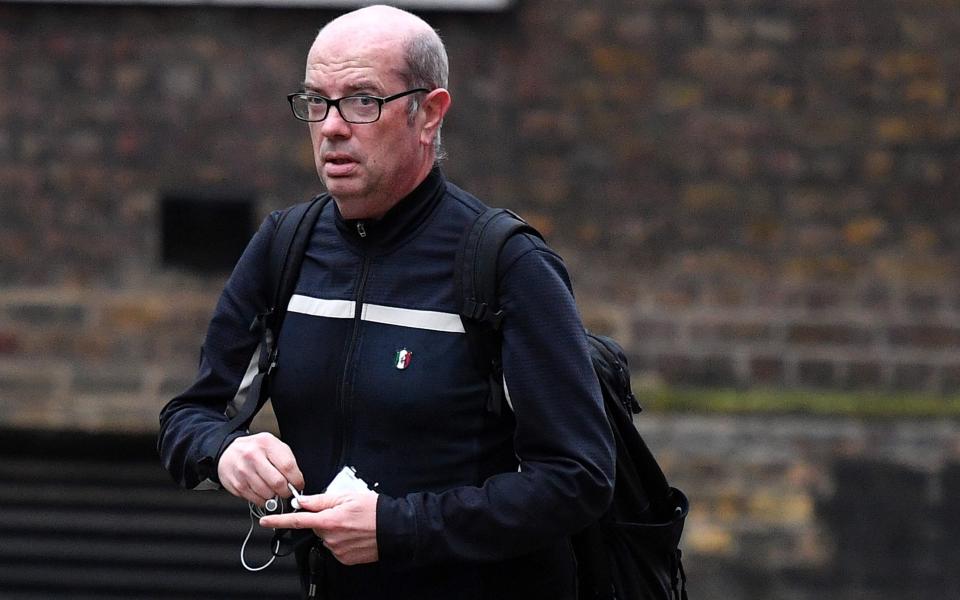Britain’s new road rage: how traffic rules are tearing our neighbourhoods apart

Last January, Manchester City Council started trialling its Active Neighbourhood scheme in the city’s suburb of Levenshulme. As part of the plan to limit traffic and create safer spaces for pedestrians and cyclists, a modal filter, as they are called, was installed at the junction of Delamere Road and Gordon Avenue, a quiet residential neighbourhood of neat terraced houses. The route for through traffic was now blocked by four large, heavy, wooden planters, sprouting flowers and shrubs – a gesture of beautification or, perhaps in light of the controversy the planters would shortly cause, a peace offering.
Within days, under cover of darkness, they had been dragged off the road and sprayed with graffiti by persons unknown, allowing traffic to pass unhindered. A few nights later, a local neighbourhood group, rejoicing in the name of the Filter Fairies, had manhandled them back into place. And there they stand now, bolted firmly into the road.
As I stood looking at them a woman walked past. Gordon Avenue, she said, used to be a rat-run. Last year, a speeding car had lost control and hit her parked car, writing it off. The filters were a godsend. Another woman offered a different view. She lived a five minute walk away on Broom Lane, a “boundary road” to the scheme that was now regularly clogged with traffic diverted from the block roads. Even before the introduction of the scheme, she said, air quality in Broom Lane had been measured above the legal limits of pollution. Now the situation was so bad people were forced to live at the backs of their houses to avoid the noise and pollution. “I’m so furious I’m selling my house because I can’t live there anymore.”
A passing man joined the conversation. “It’s like Trump or vaccines,” he said. “You’re either for it or against it.” He was for it. Through traffic had disappeared from the street where he lived. “And it’s probably put the price of my property up by 10 per cent.”
Active Neighbourhood schemes, or Low Traffic Neighbourhoods (LTNs) as they are usually called, are just one part of the Government’s drive to cut air pollution caused by traffic and encourage cycling, walking and the use of public transport.
This week sees the extension of London’s Ultra Low Emission Zone (ULEZ) which has operated since April 2019. The scheme, which covered the same area of central London as the Congestion Charge, has been extended to make the area in which the ULEZ charge applies 18 times larger. Drivers of most diesel cars will have to pay a £12.50 daily fee and drivers of lorries and busses will have to pay £100. Some 100,000 cars, 35,000 vans and 3,000 lorries could “potentially be affected” by the new rules every day, according to Transport for London (TfL) estimates.
The move has already come under criticism, but Mayor of London Sadiq Khan defended it yesterday morning, telling BBC Radio 4’s Today programme: “For me this is an issue of social justice. Who do we think suffers the worst consequences of toxic air? It’s the poorest Londoners, least likely to own a car. black, Asian, minority ethnic Londoners. Six out of 10 in the expanded area don’t even own a car.”
Similar schemes – called Clean Air Zones (CAZ) – already operate in Bath and Birmingham and are planned for cities including Edinburgh, Manchester and Newcastle. Birmingham’s CAZ, in particular, was not initially welcomed. Council leaders have admitted that they failed to explain who would be fined effectively enough, noting 93 per cent of cars are exempt. But they pointed out that the zone is already reaping benefits: nitrogen dioxide levels are down by 20 per cent compared to the figure in previous years pre-pandemic.
Everyone can agree that pollution from traffic should be reduced and the streets made safer for pedestrians and cyclists. Why then, since their widespread introduction last year, should LTNs in particular have proved a cause of such acrimony? And what can they teach us about the potential impact of ULEZ in the weeks to come?
LTNs encompass all the elements the British like to get most exercised about: class, climate change, pollution, the rights of cyclists over motorists, or vice versa, the failings of local councils – particularly when they come to enforcing things you don’t happen to agree with.
The need to reduce traffic and improve conditions for cyclists and pedestrians has been an ongoing part of political debate for decades, but Covid provided an unexpected accelerant.
In May 2020, the Government released £250 million of “emergency active travel funding” for local authorities to implement schemes including introducing cycle lanes, widening footways and closing streets. Partly a response to the need for social distancing, it was the first part of a £2 billion central funding package to create what Boris Johnson called a “new era” for cycling and walking in England.
Some 200 new schemes were introduced around the country, more than half in London. Councils were told that measures should be taken “within weeks” to take advantage of the short-term opportunity to change travel habits. Typically, consultations on such matters might last months, even years; the new LTNs would instead be given a six-month trial and then reviewed.
On the face of it, the objectives of LTNs are ones that everyone can agree with. Residential streets would be made safer for pedestrians and cyclists, with less traffic and less pollution. Indeed, it’s estimated that more than 25,000 road closures of the type used in LTNs existed before the pandemic. But as councils up and down the country hastily implemented the new measures, what happened next was something akin to the declaration of all-out warfare. Posters went up in windows, the neighbourhood WhatsApp and Facebook groups cranked into action and debate quickly hardened into dispute, anger and insult.
The poorest Londoners are least likely to own a car—and suffer most from the consequences of toxic air. The ULEZ led to an incredible reduction in harmful emissions in central London. Now millions more Londoners will benefit from cleaner air in the new expanded zone.
@SkyNews pic.twitter.com/aSK2JXqylX— Mayor of London, Sadiq Khan (@MayorofLondon) October 25, 2021
Social justice arguments
“I’ve lived here for almost 20 years, and I’ve never known anything divide the community like this,” Jeremy Hoad, chair of the Levenshulme Community Association, told me as we strolled along the high street, passing an Asian grocer, a Romanian food shop, an Irish welfare association and a new vegan café.
“This should have been a project that brought everyone together to a common goal of making our roads safer, easier to walk and cycle around – all the stated goals of the project. Instead, it’s created this massive division in the community that was completely unnecessary.”
The schemes, he said, had been foisted on people with no discussion of alternatives.
“There are all sorts of solutions that could be considered; traffic crossings, calming measures, one-way street. But we’ve been told those solutions are very 20th century and have been proved not to work. And if you question that you’re dismissed as some sort of petrol-head who’s not concerned with climate change, and not wanting to make children’s lives easier. It doesn’t do anything to help a constructive conversation about how to achieve these goals.”

The Levenshulme scheme is part of a long-standing plan to accelerate active travel in Greater Manchester.
In 2020, Manchester City Council, working with the walking and cycling charity Sustrans, and the Manchester Bee Network, drew up plans for a scheme that included the introduction of 24 modal filters around Levenshulme. The council subsequently scaled back to 14.
It’s a compromise that, inevitably, has satisfied no one.
At a stretch of grassy ground on the Fallowfield Loop, a green walk and cycleway that replaced a disused railway line, I met members of Levenshulme Streets for People, the group behind the Filter Fairies. The green was adjacent to a narrow residential road, thronged with children coming out of school. A modal filter was planned for the street, then scrapped. As if on cue, two cars jostled to pass each other, horns blaring.
Having campaigned for the original 24 filters, Hugh Dannatt, a scientist working in bio-tech, told me that the current scheme incorporating just 14 was “piecemeal”. The group had raised a petition, Join The Dots, calling on the council “to create active transport routes that connect the entire community, not just those who live on the filtered streets”.
If everyone in Levenshulme agreed on the principles of safe and pollution-free streets, I wondered, why has there been such vehement disagreement on the subject?
“Because some people are unwilling to consider changing their behaviour. Cars are seen as to do with freedom and that gets embroiled in social justice arguments – you’re making some people’s lives harder. But the primary social justice argument is surely to do with people who don’t have cars, and we owe it to them to provide a safe means of getting about.
“I think a lot of the division comes down to people who think there is a perfect solution and we shouldn’t inconvenience ourselves or go out of our way until we find it. It’s exactly the same as with climate change.”
A clear objective of LTNs is to encourage people to stop using their car for short journeys. In Greater Manchester 30 per cent of journeys up to 1km are made by car – a distance that could be walked in nine minutes or cycled in four.

Dividing opinions
It is a common complaint against LTNs that they make life better for people living on quiet roads and worse for those living on busy ones, and that in reducing, or eliminating, traffic within LTN “cells” they merely move it on to other already congested roads. There it sits idling in traffic jams, making journeys longer and slower and causing more pollution for people shopping, waiting for buses and travelling to schools and hospitals.
However, research into traffic movement as a result of LTNs suggests that low-traffic neighbourhoods do not simply shift traffic from one place to another, but a process of what’s called “traffic evaporation” leads to an overall reduction in the numbers of motor vehicles on roads. The most comprehensive study of this, in 2002, examined 70 case studies across 11 countries. This suggested that people make a series of choices to avoid congestion, changing their mode of travel, consolidating trips or car sharing. In half of the case studies, there was an average 11 per cent reduction in the number of vehicles across the whole area where roadspace for traffic was reduced, including main roads.
All of these arguments have been rehearsed in the south London neighbourhood where I live; the longer time it takes on the school run; the traffic jams; the plight of the elderly and infirm who depend on taxis; the posters in windows (Clean Air For All!), the tricky conversations in cafes and at bus stops – “Don’t mention the road closures!”
Recently, residents were treated to the unusual spectacle of some 100 people, ranging from grandparents to tots, cycling in a colourful procession along a through road, apparently in support of the scheme. A couple of weeks later, there was a public protest against it.

So where does the balance of opinion actually lie? A survey of residents in four LTNS, in Birmingham, Bournemouth, Ipswich and Manchester, conducted by Kantar for the Department for Transport and published in November 2020, showed that the vast majority of respondents agreed that the Government should act to increase road safety (90 per cent), improve air quality and reduce traffic congestion (89 per cent) and reduce traffic noise (80 per cent).
When it came to the local schemes themselves, opinion was more divided, with 61 per cent supporting them and 29 per cent opposing them.
As with anything, it is the voices on the extreme sides of the debate that shout loudest.
“I don’t know of any scheme where the entire community has said ‘Let’s have it!’ without saying ‘Well, hang on – have you thought about this or that?’” says Rosslyn Colderley, the England North director of Sustrans.
“But if you want to have streets where there’s low pollution, which are safe for children and there’s not much traffic, then, if you drive, you will also need to accept that it might affect your journey by a few extra minutes. It’s not going to be a significant change.”
‘It’s put the cause of cycling back many years’
Over the past 25 years, the number of cars in the UK has risen by 42.5 per cent. If growth continues at the same pace, we could have 45 million cars on British roads by 2045. The choice is stark: build more roads – which nobody thinks is a good idea – or make better use of the existing ones by encouraging cycling and the use of public transport.
In July, in a one-year review of the Department for Transport’s Gear Change policy, Boris Johnson announced that spending on active travel will be increased from the £257 million announced at the November 2020 Spending Review to £338 million, the money to be invested in more LTNs and upgrading the National Cycle Network.
This commitment to active travel was reiterated in the Government’s Net Zero Strategy, published last week – with the pledge to invest £2 billion in cycling and walking, building thousands of miles of segregated cycle lanes and more low-traffic neighbourhoods – with the aim that half of all journeys in towns and cities will be cycled or walked by 2030.
Councils are under orders to fall in line with the Government’s plans. In July, transport minister Chris Heaton-Harris wrote to all council leaders and combined authority mayors saying that authorities which did not take active travel seriously and “which have prematurely removed or weakened [cycling and walking] schemes should expect to receive a reduced level of funding”.
At the same time, the Prime Minister’s special adviser on transport Andrew Gilligan said on Twitter that several London councils including Harrow, Ealing and Hillingdon had similarly had funding provided through TfL stopped “pending further discussion”.
In Ealing, more than 2,000 people marched on the town hall in April protesting against the introduction of nine LTNs in the area. In September, following a review of traffic and air quality data, the council published plans to remove seven of them, retaining just two from their original plan. The council declined to comment to The Daily Telegraph on the question of Andrew Gilligan’s announcement on possible funding cuts.
Gilligan was Boris Johnson’s cycling commissioner from 2013 to 2016 when the Prime Minister was mayor of London and is now on the board of TfL. He has taken a leading role in enforcing government directives on councils that he has described in internal memos as being on “the naughty step” for removing or diluting schemes without proper consultation, or clear evidence that they are not working.

Gilligan’s harshest critic has been Andrew Boff, the chair of the London Assembly, who in 2011 was the mayor of London’s “Champion for Promoting Cycling”. In a fringe meeting at the Conservative Party Conference he described Gilligan as “the problem” behind all the issues to do with LTNs.
Goff blames what he calls the “zealotry of the cycling lobby” for antagonising people who would otherwise be sympathetic to the objectives of LTNs.
“People who are reasonable about cycling improvements have been turned into visceral anti-cyclists,” he says. “It’s put the cause of cycling back many years.”
Andrew Gilligan was not available for comment.
Chris Boardman, the Olympic gold medallist who is now transport commissioner for Greater Manchester, says that LTNs, are partly redressing a problem that has been created not only by the increase in traffic, but by the increasing use of apps such as Google or Waze “filling up” side roads with traffic that should never have been there in the first place.
“A neighbourhood isn’t a neighbourhood if it’s got high traffic. The rights of people to use the streets without a car, or for children to play safely around their home, have been taken away.”
Traffic reduction schemes have been part of town planning for years and Clean Air Zones like ULEZ are a central part of the Government’s plans to reduce traffic and air pollution. But the furore around LTNs, says Boardman, “needs to be put into context... LTNS have been packaged up into a series of measures which have all come along at once and people say, ‘What! I can’t do this or that anymore?’. But the majority have been trials, and if there’s not the fortitude to trial something for a meaningful amount of time, then we’re really in trouble.
“And anyone that objects must be obliged to come up with an alternative to these massive issues that we’re facing. To just say ‘I don’t like this’ doesn’t cut it anymore. We have to change.”
The question is, how and when? And by stick or by carrot? In the LTN wars – and the ULEZ battle – something has to give. And there is no sign of it giving any time soon.

